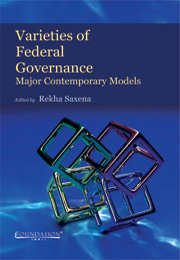Book contents
- Frontmatter
- Contents
- List of Contributors
- Foreword
- Acknowledgements
- Introduction
- I Theoretical and Comparative Dimensions
- II Presidential Federal Systems
- III Commonwealth Parliamentary Federations
- IV Non-Commonwealth Parliamentary Federations in Afro-Asia
- V European Parliamentary Federations
- VI Devolutionary Systems
- 18 The Union's Place: Scottish-English Relations after Devolution
- 19 The Federal Debate in Sri Lanka
- VII Supranational Confederalism/Federalism?
18 - The Union's Place: Scottish-English Relations after Devolution
from VI - Devolutionary Systems
Published online by Cambridge University Press: 05 June 2012
- Frontmatter
- Contents
- List of Contributors
- Foreword
- Acknowledgements
- Introduction
- I Theoretical and Comparative Dimensions
- II Presidential Federal Systems
- III Commonwealth Parliamentary Federations
- IV Non-Commonwealth Parliamentary Federations in Afro-Asia
- V European Parliamentary Federations
- VI Devolutionary Systems
- 18 The Union's Place: Scottish-English Relations after Devolution
- 19 The Federal Debate in Sri Lanka
- VII Supranational Confederalism/Federalism?
Summary
Introduction
Devolution is both a response to problems of managing the union of the four nations of the United Kingdom, and a challenge about the future character of that union. It responded to perceived problems in Scotland, Wales and Northern Ireland surrounding the legitimacy of a political system concentrated on UK political institutions in Westminster and Whitehall and dominated by its largest component, England. The challenge it has unleashed was exemplified in the processes of government formation following the devolved elections of spring 2007 – Scotland now has a government in Scotland run by a party, the Scottish National Party, which is committed to independence from the UK; the Northern Irish government is co-led by a party, Sinn Fein, committed to the unification of the island of Ireland; and Wales is now governed by a coalition of Labour with the nationalist Plaid Cymru which is committed to a referendum on further-reaching devolution for Wales.
These election outcomes suggest that the territorial configuration of political community in the UK remains contested. They also give the lie to claims made by some of the architects of Scottish devolution that the reforms reflected a ‘settled will’ (John Smith and Donald Dewar), or would ‘kill nationalism stone dead’ (Goerge Robertson). More accurate was the telling phrase by the former Secretary of State for Wales, Ron Davies, that devolution was a ‘process, not an event’, not a one-off enactment of constitutional change, but rather a dynamic whose trajectory was open and whose endpoint was unclear.
- Type
- Chapter
- Information
- Varieties of Federal GovernanceMajor Contemporary Models, pp. 433 - 446Publisher: Foundation BooksPrint publication year: 2011



